| Author | Message | ||
Easyrider |
Dannybuell, You asked: (Do the aftermarket exhausts let the engines run any cooler with reduced back pressure?) My awnser should be: Yes, It lets the engine run much cooler. (especially if you run a stock exhaust now) | ||
Easyrider |
I still think the JArdine exhaust is way too low on the scheduale for performance in the test... It makes such a huch amount of torque it's almost a wet dream.. | ||
Dannybuell |
Easyrider - THX, I was hoping that the engine would run cooler with a less restrictive exhaust. | ||
Pariah |
But I thought, according to the shootout, the aftermarket exhausts tend to push the engine into running leaner (with stock ECM) and hence even HOTTER. To reduce temps, you need an appropriately tuned ECM that will make things a bit richer and so possibly cooler. Just my dos centavos... I could be wrong here. | ||
Rt_performance |
The reason for getting the Barker specific tune is less about top end performance and more about drivability/consistency. There may be bit more top end in the Barker specific tune than the FMF one, maybe not. But AFV stability and overall smoothness will likely be better o the matched tune. AS a WOT test, the shootout really didn't evaluate that at all, that would've been way out of scope. I seen my bike generic Erik Buell Racing map and after the specific barker ebr map it made a nice smooth 3 ish horse power 5-10k Thank you so Much Al that is on awsome and complete test (Message edited by R/T_Performance on July 21, 2010) | ||
Easyrider |
Pariah, When you take a 1125CR with a stock exhaust and tune, and you take a 1125CR with a openpipe with a tune, still the open pipe mounted 1125CR will run cooler.. | ||
Swampdog225 |
Based on what I got out of the Exhaust Shootout Report, I made my decision, and purchased the FMF Apex from Al, and the Erik Buell Racing ECM for the FMF. I say again that their is no replacement for information. Thanks to all of the guys who spent countless hours working on the report. All I can say is WOW!!! A nice pipe and tune matched to it make a world of difference in how this thing performs and sounds. | ||
Stevej |
thanks Dean, got the RT-4 today and the Erik Buell Racing ECU is on the way. gonna make some noise this weekend! | ||
Dannybuell |
Stevej - Hang on tight! I am very curious to know how much of a difference a good exhaust and ECM has on the engines operation in a hot urban environment. Could you test your battery output and engine temperature values in a hot urban riding situation with before and after values? THX | ||
D_adams |
Just my observations from yesterday, 97 degrees out. Coolant was 185-187 while doing 70 mph. No real noticeable heat from the frame. At several stop lights, AT registered as high as 114 for a long light. CT never really went above 192 while I checked it. Longest stop was maybe 1 minute at a light. That said, mine has never really run super hot like some here. I had the water pump replaced due to mechanical failure back in June, temps were roughly the same from what I remember. Mine's an 08 R. | ||
Thefleshrocket |
This may have already been answered in this thread but I don't recall seeing it in the American Sport Bike writeup. Was the race tune used the generic E B R ECM tune, or were any of the pipe-specific E B R tunes used? | ||
D_adams |
The pre-programmed ecm was the FMF map, so that's probably about as good as it gets with the race ecm. 132 hp w/ 12:5 a/f mix average. It lost a hp or two with the a/f at 13:1, so ebr probably got it pretty close. You might get a couple more out of it by playing around some with the fuel, but it would take some work to get it. | ||
Redbuell1203 |
so i am unable to open up the zip files on the shoot out. Can someone tell me how the D&D actually did with and without the race ecm. I would really appreciate it thank you. | ||
Zac4mac |
Hope this works - Stock ECM ____________________Race ECM - FMF 8000 74.06 112.8 Max. Torque ______7900 76.38 114.9 Max. Torque 9800 65.8 122.8 Max. HP __________9900 68.48 129.1 Max. HP That is from the Excel sheet for the D&D...Z (Message edited by zac4mac on July 26, 2010) | ||
Highscore |
Sorry for my late comment about this so eagerly awaited exhaust shoot out. Same dyno, same bike, same dyno operator - the bike donator himself - , this should guarantee objective, reliable and comparable results. My only critic about the results applies to the "stock" performance. The stock power suffers at all the other aftermarket pipes, by the poor fueling of the stock ECM: All dyno runs have been performed with unplugged speed-sensor at the gearbox. I guess this has been done do avoid that "virtual" miles due of the dyno runs are collected by the odometer in the dashboard. Probably a race-ECM is not effected when this input is missing, but the stock ECM is different: At lest my Euro-spec ECM throws after a short period "CEL" when missing the vehicle speed data from the sensor, because it needs this signal to calculate which gear is selected. Well, the stock ECM is not famous for it brilliant fueling, its short comings have been discussed here extensively. Therefore it is hard to believe, that the stock ECM makes its job better when CEL is flashing. With CEL an ECM usually goes into a "limp home - mode". And there are different styles of this mode, the real "brutal" one, when virtual inputs are missing, where the engine runs just as so and more subtle one without any great losses in power, when the missing input belongs to a subsidiary sensor. During this "soft" limp home mode the ECM works at its internal, preprogrammed core map, without any adjustments to the ambient conditions. Of course the AFV is here strictly at 100%, but all other calibrations for temperature and pressure correction of the mixture are also switched off. I guess this is the case with the 1125 ECM with unplugged speedo sensor. And this bad fueling due of this mod may explain some curious power reading during the shoot out, using the "stock ECM". There are same pipes far off with "stock ECM", so there are ton of performance to gain by proper "jetting", other pipes are pretty close even with the stock ECM on, so there is just a little gain by an real adequate fueling. For this reason I would say the runs with stock ECM a nor really comprehensive for a comparison of the relative performance of the pipe in this shoot out. But all the other results, measured with the race ECMs are valid and show the performance differences among the tested pipes. With one exception: The stock muffler. It is tested only with that "unlucky settled" stock ECM. Therefore I have the strong believe, its real performance is a little bit underrated: With proper fuel by a race ECM also the stock pipe should be able to crank out substantial more power. Therefore I cannot believe, there are 15 HP to gain by a pipe and a proper fuel management, I would say there are only 10 to find - 5 by the pipe and 5 more by an adequate fuel supply. Please understand this as a systematic comment of mine, not as a critic at the comparison test as a whole. I really appreciate the work condensed within this test and the report describing the procedure. Furthermore I like to thank for the picture of the exhaust tested. This pics give an idea of the lay out of the pipes When looking at the results - without discussing each single HP more or less - there is a group of winners among the tested system and loser. The winners show some common design feature: All tested system merge the exhaust flow by the stock headers into a common down pipe. But the more efficient pipes show a large collector tube, preferably "assisted" by a Y-joint as close as possible to the stock primary headers. And vice versa. Prolonging the stock headers extensively is contra-productive. This kills peak power at the top. Furthermore I would also say the design of the Barker is the most advanced: Giving the common collector tube a megaphone shape, opening the internal streaming surface for the exhaust gas continuously up to the muffler, spreading the power band of the engine as far as possible. This design issues I explained above are only valid for slip on system keeping the stock headers in place. But the diameter of the stock headers is more than just a little bit to small for an engine, running at this speed with such an amplitude of wave action inside of the exhaust. In deed this headers act like a nozzle to the engine, dominating its power delivery. This phenomenon explains also, why an early and massive expansion into a large collector tube makes better power. In the case of a slip on system for the 1125, common design rules for exhaust pipes diameters are not valid. Things would be different in the case of a full exhaust system including headers. For me it is a pity that the full Erik Buell Racing pipe was not included. I would aspect some huge gains by full system, especially in peak power at the top. Another problem with the exhaust systems tested here, is its noise emission. Keep in mind that db is rated in logarithmic values. So an increase of nominal shy 3 db means a doubling of the noise energy at the ear-drum. Therefore 10-13 db more as stock means hell. There are street legal, EC-approved exhaust systems around here in Europe. This pies are as load as the stock muffler, just the note of the exhaust tone is different. It is also a pity that none of these pipes have been tested during this shoot out. | ||
D_adams |
The request for mfg's pipes went one month BEFORE the test occurred. There was ample time for any of them to send one in, Dris managed to get one here. There were quite a few that said they would send in a system and then either just didn't send one in or failed to respond to emails from Al after the initial contact. As Al noted in the report, it was something that should have been tried (race ECM with the stock pipe) but hindsight is 20/20. To expend the amount of time and resources they all did was not a cheap venture and to say "Hey, you guys did it wrong or forgot this or that" isn't necessary. Maybe you can do one for all the euro spec pipes over there and do the testing exactly the same way it was done over here by Al and the crew at JT&S. Make sure you get a TH pipe and normalize the testing based on what it showed in this test. You have known variables here, what the stock pipe got as well as the TH. Maybe run with it from there? I'm sure there's a lot of guys over there that would like to see some of the pipes made locally in testing, they were certainly missed. Personally, I don't have that kind of money or time to do it, much less the facilities, so I won't complain about how things were done. I'm just happy that it _was_ done. (Message edited by d_adams on July 28, 2010) | ||
Highscore |
"Make sure you get a TH pipe and normalize the testing based on what it showed in this test." The TH is the Torquehammer and this pipe is the reference to validate any European testings? For sure not. The reference to validate any gain of an aftermarket pipe is the stock muffler. This pipe is the only criterion to compare any gains with, no matter if we are testing in the States or anywhere else. My critics regarding the test procedure belong solely the results according the stock muffler. And additionally I am missing an "all stock" test at the end of the whole comparasion test procedure. Engines are not pure mechanic, they are living and changing its properties over time. To be sure, to measure the "reality" it is therefore necessary to repeat this initial "all stock" measurement with the stock muffler at least at the end of the test cycle. When UI made the first test run with my own 1125 I saw disappointing 116 WHP all stock. No I have 138. Does this mean, I have found a + 20 HP-tuning package? Unfortunately not. I needed a long time to discover the reason for that poor performance of my bike, when it came in: It was is severe mismatched fueling by that unhappy AFV-management by the stock ECM. After a reset by the dealer and some riding in cold mountains, there was a lot of more fuel around in the engine and he HP reading increased without any other mod up to 128-130 HP. Therefore I have troubles to accept such low power reading for "all stock" like just 120 WHP. I am aware, there are some dyno graphs around here, which show similar disappointing readings. I feel sorry with the owners. But this is not normal. This is not the fault of the Rotax engine. It is solely caused by this strange and unusual strategy of the Buell ECM to calibrate the fuel according what it has learned during closed loop and at partial load. | ||
Fresnobuell |
Therefore I have troubles to accept such low power reading for "all stock" like just 120 WHP Hard to compare dynos between shops let alone continents. Remember dynos vary wildly across the board. The Shootout is by far the most scientific method available to us (the only one?) I will say it seems possible to get an idea of HP figures when you look across a decent sized sample. For those who were around way back when the first '08s came off the line, I can remember dyno runs pretty consistently hovering around the 130 mark bone stock. Since the series of re-flashes the new "norm" for a stock motor is around the low-120s. What changed? My theory is BMC traded some top end fueling for some bottom end-fueling for better driveability. | ||
Cowboytutt |
Well, I hate to be unkind but I think the manufacturers would want to know that the Torque Hammer exhaust sounded positively the WORST out of the entire field of exhaust participants in American Sport Bike's testing. Even if it made the best HP and torque gains I would never consider it for purchase. Sorry guys! But hey, I'm also a Harley rider with a Rinehart 2-1 exhaust and love it to death. So what do I know! -Tutt | ||
D_adams |
What I was getting at was, if _your_ stock bike shows 125 hp, then the TH _should_ show about 133-134 hp if it's normalized to the test that was done by Al. If your stock bike shows 130 hp, then the TH should be at about 137. If thats the case, then the top four pipes would have numbers well over 140 hp at the wheel, the best one at almost 147 hp. This assumes the same 13% gain over the stock exhaust. Even if you fudge the numbers and only allow for a 10% gain, the top systems will average 13 hp over stock. It's already been documented here in the US. The spread in hp was about 9 or 10 hp between mfg's pipes. The top 4 showed about a 12-13% gain with a race ECM, whether you want to believe it or not. | ||
Firemanjim |
I don't remember the speed sensor being unplugged at all,but will check with Al and Terry to make sure. And we did a couple runs early on before testing with Speed sensor unplugged because we could monitor AFV on the dash this way(seems as soon as bike sees any speed the AFV monitor goes away) and get Davids bike back to 100%--it was out on one cylinder. Not the normal testing.And as far as we have been able to determine with all the Buell testing we have done, there is not a limp home mode as you refer to. And the reason the Erik Buell Racing system was not tested is it is a FULL SYSTEM and requires dropping the engine to install and that was not going to get done in the time we had.We have this on one of our customers bikes it is very nice and makes great power gains. (Message edited by firemanjim on July 29, 2010) | ||
Easyrider |
I think the Jardine Good be the winner, because it makes more HP then the Barker: the Jardine makes more top HP then any aftermarket i have on the dyno, with a stock ECM. I don't talk about Torque only Peak HP.  | ||
Westmoorenerd |
Man, I hate seeing all this bickering.... The shootout was meant as a means of comparison. As we all know different dynos give different readings. So Easyrider, sorry, but the results you have can't be compared to the shootout's results. Just be happy that Al took his time for this... No one else has or would, so there's no room to criticize. | ||
Highscore |
The Torquehammer, the Barker, the Jardine, the FMF.... Let´s stop talking about brand marks. What really makes the performance of a pipe, is it tubing, its design, lay out and internal "physics", not the name plate out the muffler shell. So the real winner is the Jardine? I am little bit confused, to hear´this from you Easy, since I thought your TH is the final masterpiece of exhaust development. Looking at the pics, the Jardine and the FMF are brothers in mind regarding their exhaust design, just the muffler has a different appearance. So why should the Jardine do something better as the FMF, as far as the internal core of the muffler is the same. This detail is not visible at the pics. Regarding "reference": Why should I test a TH and not the Jardine to validate the gain compared to the stock muffler? Well, I did this. I did not purchased a Jardine or a FMF, but a added a straight thru race can to the "new" collector pipe (2 1/4 inch) merging both stock headers. The space available and ground clearance issues "define" this lay out without much freedom of variation, so the length of the slip on and position of the muffler is given "automatically". Such a slip on arrangement works in terms of performance. Its "only" shortcoming is its tremendous noise. And of course I have tested the relative performance compared to stock. But I never saw 13 HP gain, simply because I started with 130 with the stock pipe. +140 just be a pipe swap would be marvellous, but this is just a dream: I measured a gain of 5-7 HP compared to stock. In deed it is hard to compare measurements from one dyno to another. But only in terms of maximal power regarding the "numbers". No matter which dyno is used, as long as it is operated in a constant, repeatable manner, should allow a comparison of the relation: No matter which numbers the dyno shows, there should be a relative and visible difference between "before" and "after", "all stock" and "aftermarket pipe". The margin of that difference should be the same, no matter which dyno is used. And here + 13HP would be equivalent to 10% more. 10% more and better performance just by a pipe swap? This would only be possible, if the stock 1125 muffler covers some serious internal restriction, creating tons of back pressure. But this is not the case. If have measured the back pressure of the stock muffler. This value is surprisingly low. The diameter of its internal baffles is dimensioned "healthy". There are two outlet pipes side by side, whose summary streaming surface is not to bad. This is the explanation why the stock muffler is not so bad. And this is also the explanation, why the gain by a pipe swap is limited: If an aftermarket pipe creates some 5% better performance, 5-7 HP, it makes the best possible. In my opinion, all other ratings are either the result of a poor initial "all stock run" , wishful thinking are guided more by "marketing". | ||
Easyrider |
Highscore, You say it right We build a pipe for low end Torque Not for High end HP. So the Jardine wins with HP at 10500 RPM. HP and Torque don't go together when you want low and flat torque curve I did the same with the developing of the Torque Hammer for the XR1200 look here: http://www.twinmotorcycles.nl/artikelen.asp?aid=75 You can see what i can do with 1 pipe to make it the way i like look down all development is 1 system  Here the end result is choose to keep after all the testing flat torque  The same we did with the Torque Hammer for the 1125. We are not here for winning peak HP we are here becuase it is Torque that moves us. and i agree the stock muffler is a very good designed pipe, most aftermarket suppliers dont even make that amount of HP, only it sucks on low end Torque (Message edited by easyrider on July 29, 2010) | ||
D_adams |
I picked that arbitrarily just because it's made over there. You can use any pipe you wish from the shootout. Fabricating a new pipe with dimensions that don't match anything that was used in the test does nothing for the comparisons. I'm not sure anyone builds a pipe with a 2.25" midpipe, although I could be wrong. The Jardine/FMF/D&D use a 2" pipe from what I've seen. Stock 1125 70.24 tq, 121.6 hp. RT-1 79.09 tq & 129.8 hp Drummer 78.78 tq & 125.7 hp Barker 72.67 tq & 125.9 hp RT-3 74.31 tq & 128.3 hp What that only shows is the peak numbers, it doesn't show the spread at a range of rpm. Several of the pipes above showed an EASY 12-15 hp and 8-10 ft/lbs tq gain over stock WITH THE STOCK ECM. Not at redline, but between 6-8000 rpm. If you lower the threshold to 10 hp and 6 ft/lbs, the rpm range stretches much farther, essentially across the entire useable rpm range. Useable to me, even though it's not shown in the tests starts at 2500 rpm. The charts only go down to 4500 rpm, but you can get a general sense or idea on where it's at. If a pipe is showing 8 ft/lbs torque over stock at 4500 rpm, that should indicate that it was doing reasonably well below that. I don't do it all the time, but the combination of the race ecm and any of the top 4 pipes, you can run the engine down as low as 2100 rpm in 6th gear (that's 36-37 mph if you're curious) with very little chugging or jerking and cruise there, but still have enough power available to pull right out of it. By 2500 rpm, it's starting to accelerate pretty hard, especially compared to a stock pipe/ecm combo. You simply can't run the stock setup that low without being thrown off the bike or doing damage to the engine or belt. 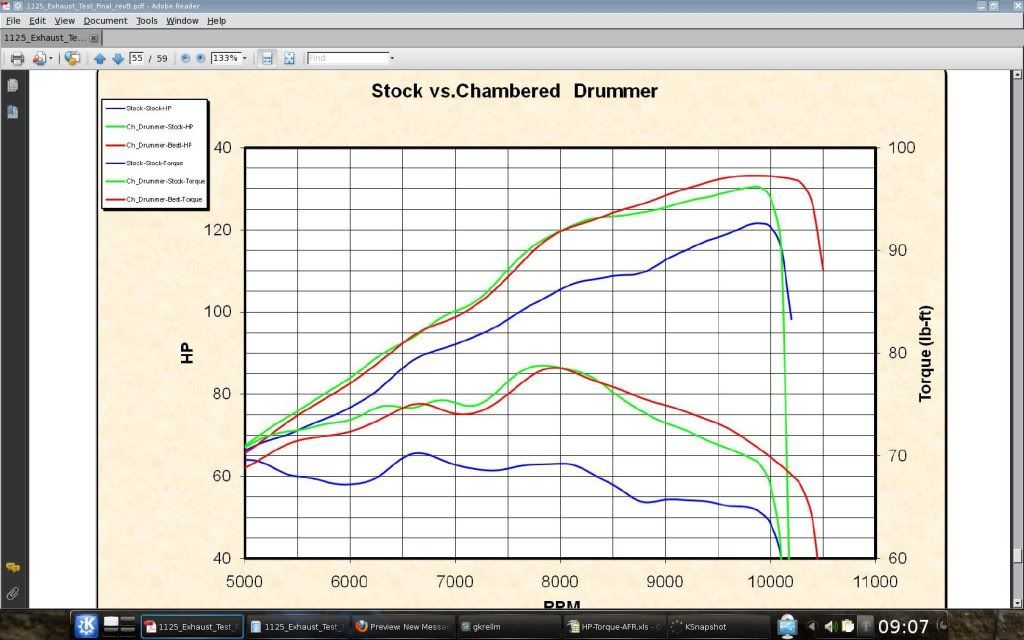 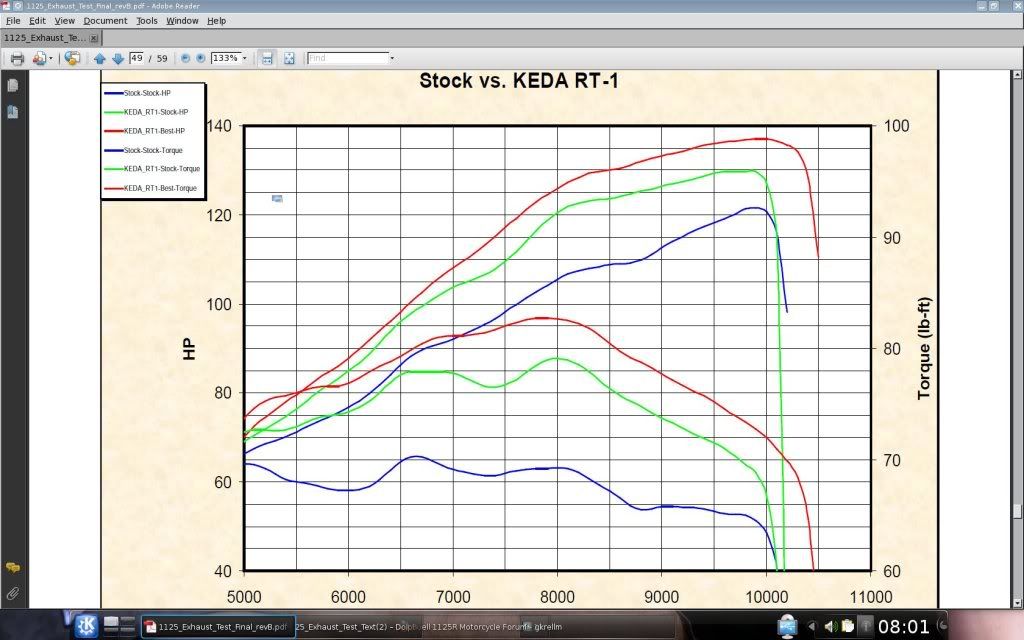 | ||
Stevej |
Dean, got the pipe and ECU on a couple days ago. man this thing rocks now. very torquey power band for around town, the ECU's cutting down on engine braking did take some getting used to. thanks. | ||
Highscore |
Thank you, Dean, for posting these dyno-charts. These screen shots lay exactly the finger onto my problem, I have with the "stock" dyno runs in this shout out: 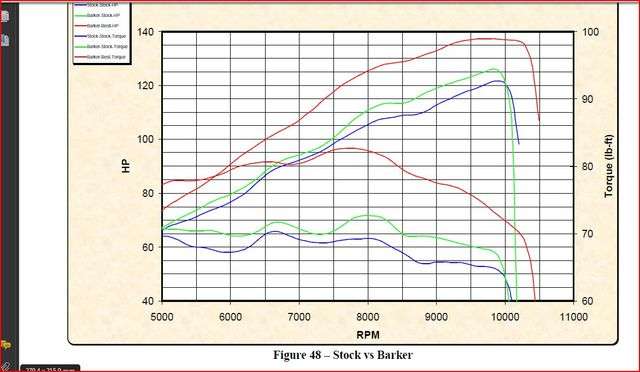 This is the performance of the Barker compared to "stock". As we can see, the relative gain by this pipe is pretty limited to shy 5HP "approx.) with the stock ECM in place. The Barker as all other pipes need some fuel by a "race"-ECM to present their full potential. Only the Keda-pipe and the chambered Drummer are real screamers, even with the fueling by the stock ECM. On the other hand in the case of these two pipes, the possible gain by "jetting" the ECM to performance is pretty little. For me, this strong "stock-ECM"-performance of the Keda and the Drummer is a curiosity. This phenomenon cannot be explained by a "better efficiency" of these two pipes, simply because with proper racer-ECM fuel inside, these two pipes do not make any better power, in fact the Barker (as the winner (?) of this shoot out) for example offers slightly more of ft-lbs and HP. I have no reason to doubt that the Keda and the Drummer showed such an extraordinary performance, when tested with the stock ECM. But I have the strong believe, that on this day, during said dyno run, something coincidental, like a change in ambient conditions, must have happened, so that the fueling of the stock ECM matched better to the needs of the engine, which let it perform pretty close to perfection. If now the other pipes would have been tested also at these perfect day (for the stock ECM), they would have also cranked out substantial better "stock" power. And this should be valid not only for the aftermarket pipes tested, BUT ALSO FOR THE STOCK MUFFLER. To say it again: I really appreciate the effort and work, Al has done with this test and the report about it. I have no doubt about its results and the objectivity. My only critic point is the poor performance of shy 120 HP for "all stock" with the Buell-muffler in place. Here I guess, if this muffler would have been tested at a "perfect day" for the stock ECM, the base run would be around 125-128 HP. So my critics belong only to a detail of this shoot out, But I think to an important one: If the stock engines performs in an objective manner the possible gain by bolt on tuning boil down to more realistic numbers: 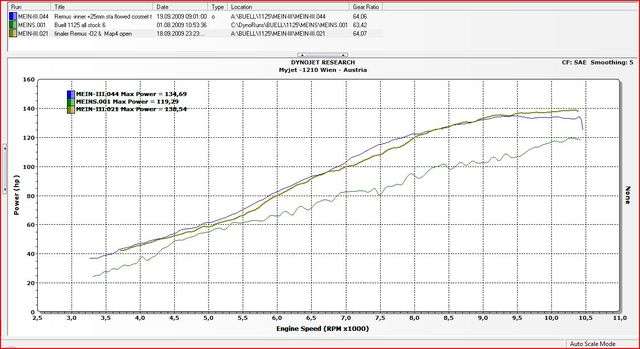 This charts shows my bike´s development of performance, starting with the initial run, when purchased it and had no sense for the fuel-problems of the stock ECM and the difficulties tom measure this Buell accurately on the dyno, and ending with my actual state of tune. Same bike, same dyno, same operator. If I discovered the 20 HP - bolt on - tuning package? Unfortunately not. The half of this impressive gain is caused by "poor" conditions for the all stock run. In fact my 1125 is good for something around 130 WHP, which are nicely repeatable, if the fueling and other conditions are constant. @ Easyrider: I know you like "reading between the lines". Therefore you should not have a problem, if I do the same with your postings: You say you tune exhaust preferably for mid range torque instead of peak power. This means "between the line", you are making mediocre pipes. Only a mediocre pipe is tuned for either for the mid range or the top end. A real sophisticated pipe lay out may on the other hand my be identified by the feature, that it offers the best of BOTH worlds, mid range torque AND peak power: well selected primary headers are responsible for peak power, the proper dimension of he tubes "downstream" the system as there are the collector tube, its shape and overall length make the mid range. BTW: I am little bit confused, that you present here a graph of your - in the run the system is called "BOS" (exhaust manufacturer in the Netherlands, so who has created ii? - pipe for a Harley XR1200. O.K. nice graph. But instead of talking about Harleys I would have awaited a comment by you regarding the disappointing performance of your "outstanding" TH-system for the 112 in this shoot out. So I do not want to comment here your XR-pipe, instead I like to talk about 1125 pipes and engine tuning: The upper graphs within my chart above show the performance of short stock stacks, the lower the result of prolonging the velocity stacks by approx 1 inch: 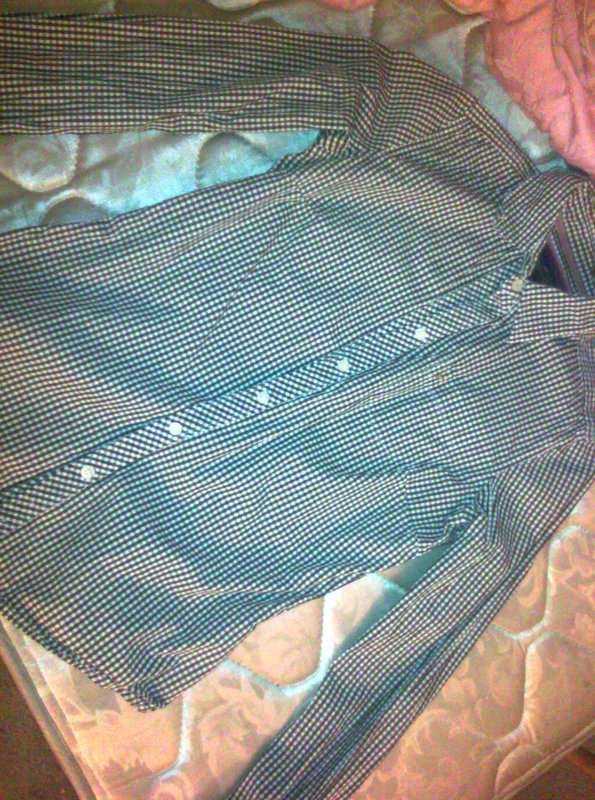 So, Easy, you see, I have a sense for "gambling peak power against torque". This is the effect of making stacks longer: you loose some few HP at the top to gain a whole bunch in the middle. Since I am riding preferably on the street on tight mountain roads, I pay this price willingly. I do not want to hyjack this thread with my own tuning-recipies, I only want to lay the focus at 1125-exhaust tune: As long as we are concerned with slip on - systems, where the stock headers remain in place, the major and most important item for the exhaust tune is given and fixed: the slim stock primary headers. These stock headers predominate therefore the range, where a possible aftermarket slip on delivers power. The stock muffler, discharging the exhaust flow of that primaries directly into an large expansion chamber, is tuned for high rpm. The short intake stocks are tuned for the same range. Consequently the stock muffler and stock engine set up by the tune of the intake ram concentrates performance around and behind 10000, where the engine makes best power. In that way the stock engine tune and set up is that of a pure "screamer". Here we find also the explanation, why the stock engine suffers so at low rpm (it is a pity, that the dyno reading in the shootout start at 4500, starting the measurement earlier would demonstrate this short coming clearer). From my point of view a perfect slip on system is one, which keep that "screaming feature" of the stock exhaust arrangement and adds some mid range torque and low end grunt to the power band. According this analysis the design of an efficient slip on system for the 1125 is pretty straight forward: To keep that "screamer feature" for maximum power, it is necessary to join the primary headers as soon as possible into a common down pipe to assure an expansion and wave reflection at the end of the primaries, similar to their aperture into the expansion chamber of the genuine Buell muffler. For this purpose the single down pipe, merging both stock primary headers after the y-joint, preferably needs some diameter, to assure that desired wave action. I am really happy about the results of this exhaust shoot out, because they give the proof for this analysis: The losers: 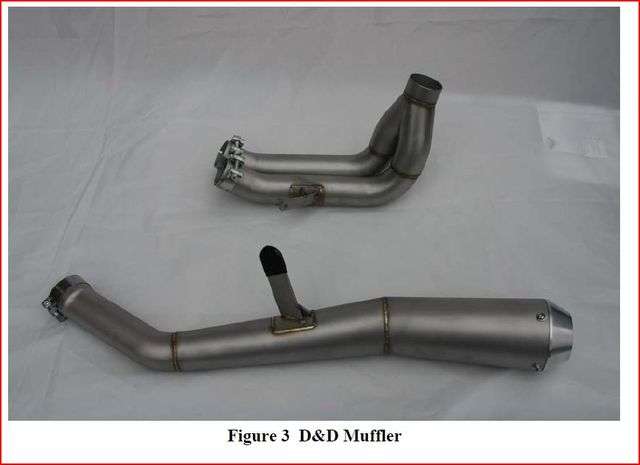  The winners:  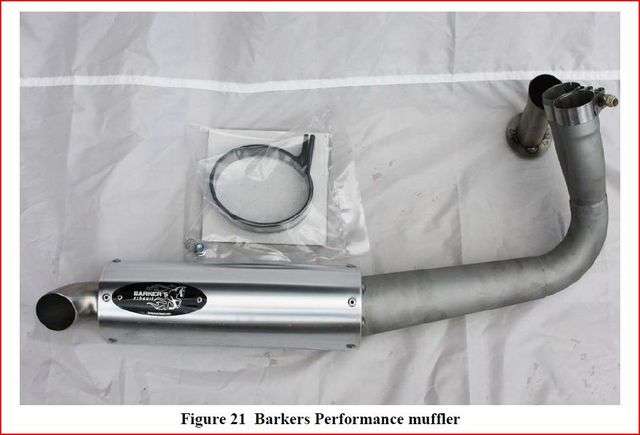 "Winners" are here the examples for a pretty efficient design, "losers" for a less efficient. There are some pipes "between", featuring an "early" joint, but a slim down pipe like the FMF and Jardine, or a late joint, but a large down pipe like the Keda. Both, the "early" positioning of the y-joint and the size of the diameter helps to assure a strong transition wave action and reflection at the end of the primary headers. At least one of these features should be realized at a working system, both are of course preferable One system I have forgotten in this analysis: the Torquehammer, since I am sure Easyrider will make his own comment. And there is a system I like to present here: The actual Remus-pipe, I am riding on my bike. This exhaust became ready and available early May of this year, too late to be a part of this comparison test. O course it covers all the features, mentioned above: 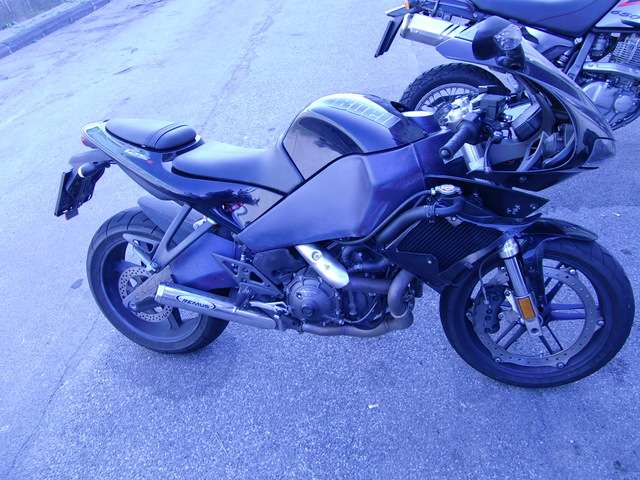 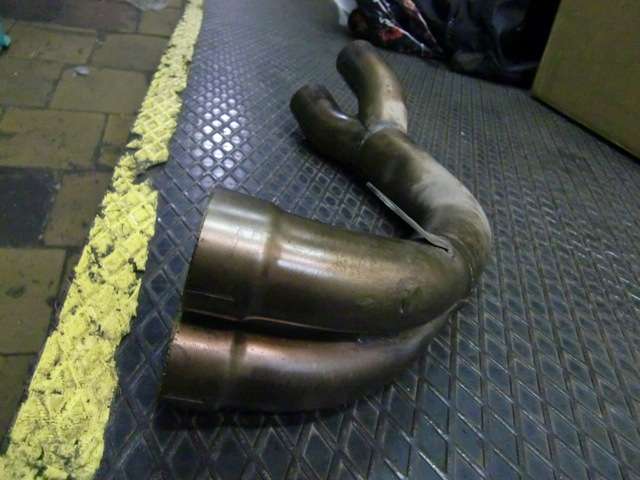 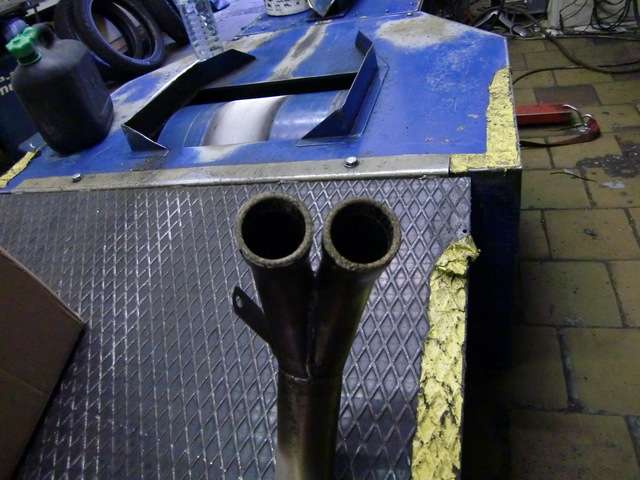 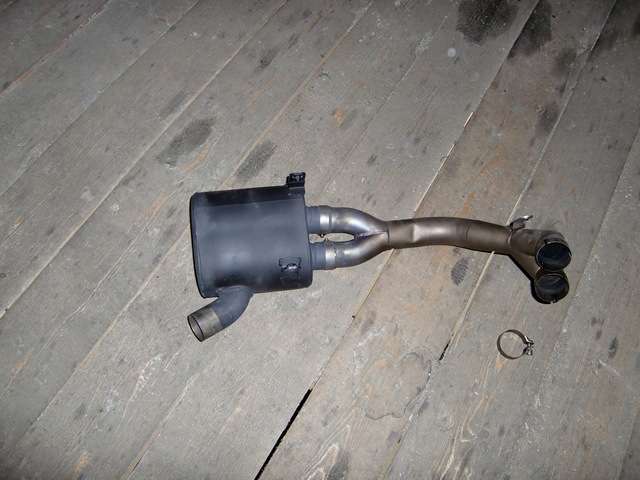  More for elegance and better looks there are short stubs positioned in front of the Y-joint, which is incorporated into the "bow" downwards. But these stubs have 2´´ (therefore the gaskets to fix them to the stock primaries) and are followed by the y-joint in a rather short distance. So the expansions of the exhaust gas flow at the end of the stock headers starts still as early as possible, "working" over the whole distance via the Y-joint and into the single down pipe. This pipe has an diameter of 2 1/3´ and is separated in front of the muffler into two parallel 2´- ducts, ending into an expansion chamber inside of the muffler. The muffler is "chambered", the extension tube at its exit tunes the damping-frequency of this "Helmholtz"-arrangement to match the noise limits. So the "working scheme", the expansion inside of the Remus pipe ducting, should be pretty the same as in case of the Barker with its conical down pipe. Accordingly the performance should be similar. The only difference may be the noise output: The Remus is street-legal with an EC-approval, as "noisy" as the stock muffler. And it covers a catalytic converter. For an EC-homologation not only the noise but also the exhaust emissions are tested. Without cat is is impossible in our days to pass this emission-testing.. The dyno runs above of my 1125 are made with this real street-legal exhaust. It is a pity, that is became available so lately. May be there is a chance to test this Remus at another opportunity in this auditory. (Message edited by Highscore on July 30, 2010) (Message edited by Highscore on July 30, 2010) | ||
Al_lighton |
I sent the programmable ECM with the same "race map" (the Erik Buell Racing FMF map) to Terry, who will get David's donor bike (the same one used in the shootout) onto the dyno and do some stock ECM vs race ECM runs. The tuning headers are already off the bike, they aren't going to tune it, they're just going to do the stock runs and the race runs. It isn't quite the same as having done it then, the headers are different, the weather will be different, but at least the bike and dyno will be the same. I'll add the results to the test report appropriately when I get them. Al | ||
Jion |
I want to say first - I am not a mechanic or a motorcycle tuner - just an avid rider for over 37 years. The back and forth over the various dyno runs is very interesting. Some of the conclusions I have a hard time seeing or agreeing with, but... that is my opinion. What I do see is nobody has mentioned the time-to-speed results, especially the 60-140mph one. One can argue "my results did this" or "my stock bike with stock ECM has this much HP" all day long. The purpose of this test was to compare various slip-on exhaust systems with ECM tunes that the average joe (read me) can readily get. When the "horsepower hits the road" and you can shave almost a full second off of the 60-140mph time (Barkers), that tells me more than any dyno. Of course now we will get the posts on how "un-scientific" this measurement is. However, the time of all the exhausts tested track with the the HP and Torque curves. Further - the best performing pipe/ECM sets (KEDA and Barkers) had almost equal time decreases in the 60-100 and the 100-140. That indicates the motor is making best HP/Torque over the entire RPM range used in the run. The other combos had lesser time gains in the 60-100 than the 100-140 which (as matched on the charts and graphs) they did not fully "tune" the engine over the widest RPM range. I may not be ready for the Isle of Man TT, but I would take that 0.9+ seconds time edge in the straights over any dyno run.  |